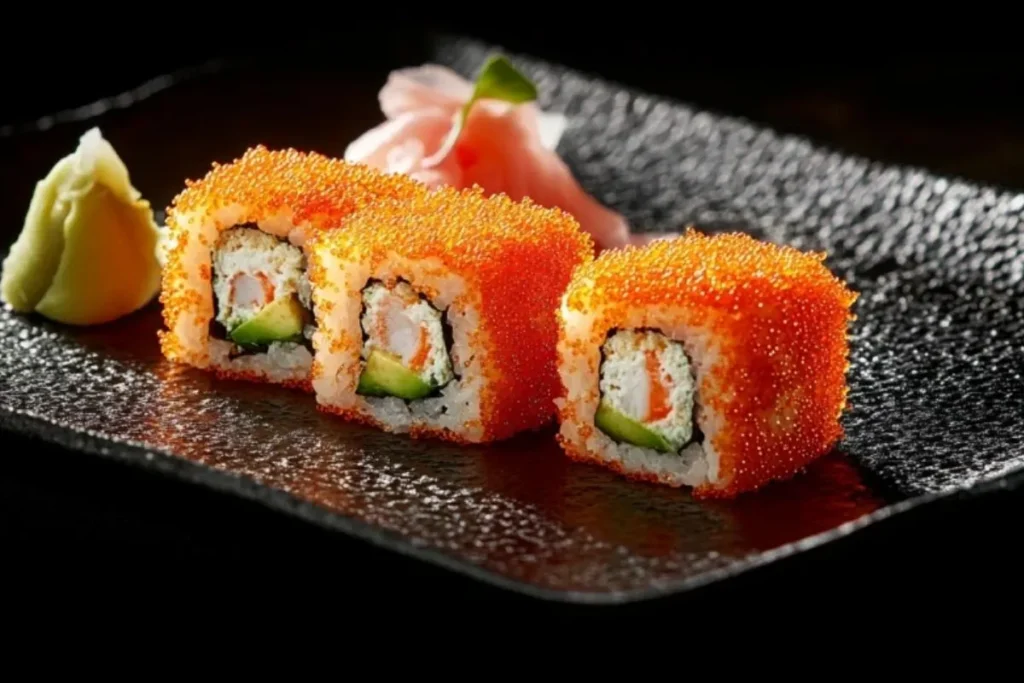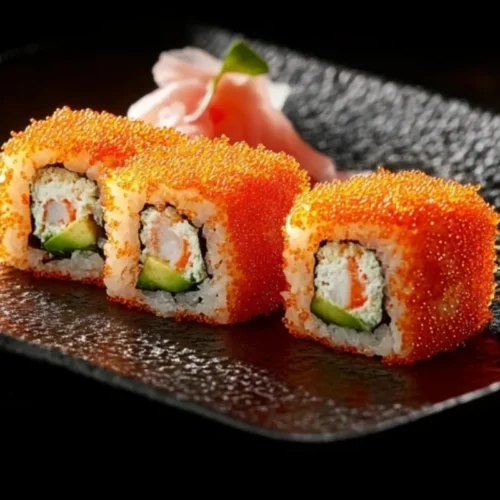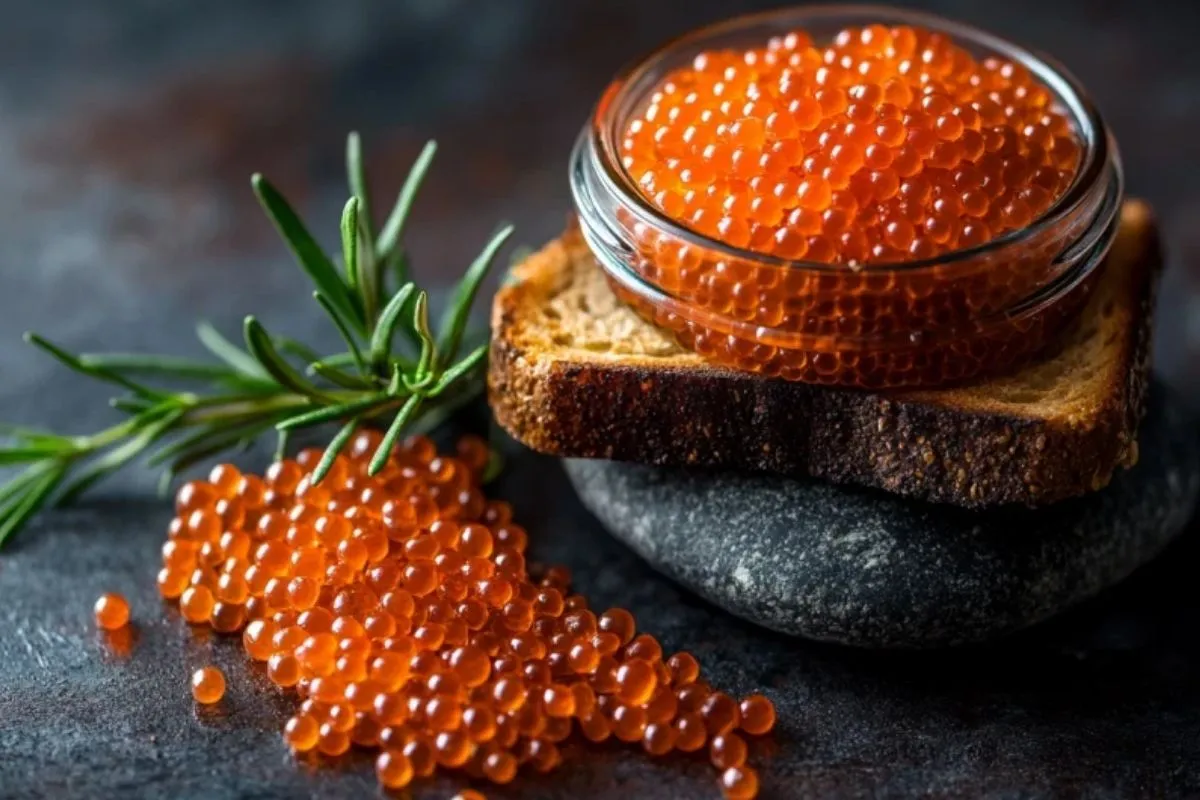a dazzling splash of color atop your sushi, each tiny bead delivering a satisfying crunch and an explosion of flavor. Known for its vibrant color and delicate texture, it holds a cherished place in Japanese cuisine. Derived from flying fish roe, it symbolizes elegance and indulgence, often adorning the tops of sushi rolls with its distinctive crunch. Beyond its visual appeal, it embodies a connection to tradition, enhancing the finesse of dishes such as tobiko sushi. Its unique ability to blend a subtle saltiness with a touch of sweetness makes it a versatile and popular ingredient in culinary creations around the world.
Table of Contents
Understanding Tobiko
What Is Tobiko?
is the roe of the flying fish, commonly used in Japanese cuisine. Harvested from the eggs of the fish, it undergoes a meticulous process where the eggs are carefully extracted, cleaned, and then prepared for culinary use. The eggs are often dyed vibrant colors like red, green, or black to enhance their visual appeal. Is typically served atop sushi or incorporated into various dishes, adding a crunchy texture and subtle salty flavor that has made it a beloved ingredient in many seafood creations.
What Does Tobiko Taste Like?
It offers a distinctive, slightly salty and sweet flavor. The natural saltiness of the egg is complemented by a subtle sweetness, making it a great addition to many dishes. Its most notable feature is its crunchy texture, which adds a satisfying contrast to softer ingredients. Whether used in tobiko sushi or as a garnish, the delicate and bold flavors elevate the overall dining experience. The vibrant colors and refreshing bite make it a unique and versatile ingredient in seafood cuisine.
Tobiko vs. Other Roe Options
Tobiko differs from caviar and masago in several key aspects.
- Taste: While caviar offers a more delicate, refined briny flavor, is slightly sweeter and more flavorful with a subtle crunch. Masago, being smaller, has a milder taste and less complexity .
- Texture: Tobiko has a notable crunch, providing a satisfying burst, whereas caviar tends to be smoother with a melt-in-the-mouth quality. Masago, on the other hand, has a slightly finer texture but is less crunchy .
- Cost: Generally, Is more affordable than caviar, making it an accessible choice for many. It is also typically more expensive than masago, which is a less premium option in terms of price.
Each egg adds a unique experience to dishes like tobiko sushi, where it is often prized for its vibrant color, texture, and versatility.
Exploring the Varieties of Tobiko
Types of Tobiko
Tobiko comes in various vibrant colors, both natural and dyed, each adding a distinct visual and flavor appeal to dishes:
- Orange : The most common variety, offering a mild, slightly sweet, and salty flavor with a satisfying crunch.
- Red : Often infused with chili or other spicy ingredients, adding a subtle heat and enhancing its briny undertones.
- Green : Typically flavored with wasabi, providing a sharp, zesty heat that pairs well with sushi.
- Black : Colored with squid ink, this variety has an earthy, smoky taste, offering a more intense, savory flavor profile.
Each color variation contributes unique nuances, allowing for culinary creativity and visual appeal.
Black Tobiko and Its Unique Appeal
Black tobiko is distinguished by its unique flavor and stunning appearance. It is colored with squid ink, and provides a more intense and delicious smoky, earthy flavor than other tobiko. This distinctive taste enhances sushi and other dishes, adding depth and complexity. In terms of presentation, its deep black color creates a dramatic contrast, making dishes visually captivating. Whether used as a garnish or a main ingredient, it adds flavor and elegance, elevating the overall culinary experience.
Culinary Uses
Tobiko in Sushi
Is commonly featured in classic rolls like California and spicy tuna, where its vibrant texture adds a crunchy, salty bite. It also graces nigiri, enhancing both flavor and visual appeal.
How to Use Tobiko Beyond Sushi
For an inventive twist, tobiko sushi can be incorporated into pasta dishes, adding a briny crunch to creamy sauces. It also elevates salads with its vibrant color and texture. In fusion dishes, try topping tacos or rice bowls with tobiko for a unique flavor contrast, blending traditional and modern cuisines.

How to Buy and Store
Where to Buy Tobiko
When shopping for tobiko sushi, several reputable markets and online retailers offer high-quality options. Look for specialty Asian grocery stores or trusted online platforms like Amazon or Asian Food Grocer. To ensure top-notch quality, check for freshness, packaging, and sourcing from reliable suppliers. Opt for products labeled “non-processed” to get the best texture and flavor.
Tips When Buying Tobiko
When purchasing tobiko sushi, key indicators of freshness and quality include bright, vibrant colors and a firm texture. Fresh tobiko should have a crisp pop when bitten, not mushy or dry. The packaging should be sealed tightly, and the product should be stored in a refrigerated section. Avoid any tobiko with an off-putting odor or discoloration, as these are signs of spoilage. Make sure to verify the expiration date to guarantee maximum freshness.
Storage Best Practices
For tobiko sushi, short-term refrigeration is ideal, typically keeping it fresh for up to 3-4 days. After opening, store it tightly sealed in the fridge to prevent air exposure. For long-term storage, freezing can preserve it for several months, but it may affect texture. To maintain optimal taste and texture, it’s best to consume frozen tobiko sushi soon after thawing, as repeated freezing can degrade its quality.
Nutrition and Safety
Tobiko’s Nutritional Profile
It contains beneficial nutrients, including omega-3 fatty acids, protein, and essential minerals. A typical serving provides about 30-40 calories, making it a low-calorie, nutrient-rich addition to meals.
Is Tobiko Safe to Eat Raw?
When consuming tobiko raw, ensure it’s from a trusted source to minimize risks. Check for freshness, proper storage, and hygiene. Be cautious if pregnant or immunocompromised, as raw fish roe may contain harmful bacteria or parasites. Always store it correctly to maintain quality and safety.
Frequently Asked Questions
How healthy is tobiko?
When eaten in moderation, it can be a nutritious addition to your diet. It is a good source of protein, omega-3 fatty acids, and essential vitamins and minerals, such as vitamin B12 and selenium. However, it is also high in sodium, so those watching their salt intake should be careful. Additionally, the calorie count can vary depending on the preparation and ingredients added. Overall, tobiko can be part of a balanced diet, but it is best enjoyed in moderation.
Is tobiko real fish eggs?
Yes, is indeed real fish eggs. It is the roe (eggs) of the flying fish, commonly used in Japanese cuisine, especially in sushi. These small, crunchy eggs are often flavored and dyed to enhance both their taste and appearance in dishes.
Does the color affect the taste?
The color does not significantly affect its taste, as the flavor is determined primarily by the egg itself. However, colored varieties such as red, green, and black often have subtle flavor enhancements from added ingredients, such as spices or seaweed extracts. Vibrant colors are more visually appealing, enhancing the beauty of sushi or other dishes.
More Recipes to Love
- Salmon Rice Recipe: A Delicious and Nutritious Meal
- Easy Salmon Loaf Recipe
- How to Make Perfect Over Hard Eggs
Final Thoughts
The unique fish roe is known for its vibrant colors and delicate, sweet-salty flavor. Its crunchy texture and visual appeal make it a versatile ingredient in a variety of dishes, especially sushi. Beyond sushi, it can be incorporated into pasta, salads, and mixed creations, enhancing flavor and presentation. Exploring tobiko in a variety of recipes opens up opportunities to elevate meals with its distinct taste and beauty. Whether as a topping or a filling, its versatility offers endless culinary possibilities.

Tobiko What Makes This Fish Roe So Unique
Ingredients
- 2 cups sushi rice
- 2 1/2 cups water
- 1/3 cup rice vinegar
- 2 tablespoons sugar
- 1 teaspoon salt
- 10 sheets nori (seaweed)
- 1 avocado, sliced
- 1 cucumber, julienned
- 200 grams fresh salmon, sliced
- 3 tablespoons tobiko
- Soy sauce, for serving
- Pickled ginger, for serving
- Wasabi, for serving
Instructions
- Rinse the sushi rice under cold water until the water runs clear. Combine rice and water in a rice cooker and cook according to the manufacturer's instructions. In a small saucepan, combine rice vinegar, sugar, and salt. Heat over medium heat, stirring until sugar dissolves. Let the mixture cool. Once the rice is cooked, transfer it to a large bowl and gently fold in the vinegar mixture. Allow the rice to cool to room temperature.Place a sheet of nori on a bamboo sushi mat, shiny side down. With wet hands, spread a thin layer of rice over the nori, leaving a 1-inch border at the top.Arrange slices of salmon, avocado, and cucumber horizontally across the center of the rice. Sprinkle tobiko evenly over the fillings for added flavor and crunch. Using the bamboo mat, carefully roll the sushi away from you, applying gentle pressure to ensure a tight roll. Seal the edge with a little water.Using a sharp knife, slice the roll into 6-8 pieces. Repeat with remaining ingredients. Serve the Tobiko Sushi Rolls with soy sauce, pickled ginger, and wasabi on the side.

